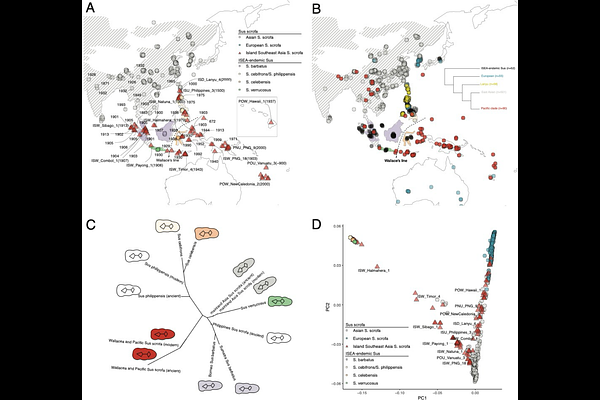Genomic and morphometric evidence for Austronesian-mediated pig translocation in the Pacific

Genomic and morphometric evidence for Austronesian-mediated pig translocation in the Pacific
Stanton, D. W. G.; Manin, A.; Evin, A.; Tabbada, K.; Linderholm, A.; Drinkwater, R.; Thalmann, O.; Ng'ang'a, S. I.; Amano, N.; Anderson, A.; Barnett, R.; Barriere, P.; Bedford, S.; Bellwood, P.; Brumm, A.; Tien, T. C.; Clark, G.; Crooijmans, R.; Cucchi, T.; Eusebio, M.; Girdland-Flink, L.; Galbusera, P.; Groenen, M.; Hakim, B.; Hawkins, S.; Heiniger, H.; Helgen, K. M.; Herrera, M. J.; Hunt, T.; Kitchener, A. C.; Lee, C.; Macdonald, A. A.; Megens, H.-J.; Meijaard, E.; Mitchell, K. J.; Moran, C.; Mudar, K.; Nidup, K.; Oxenham, M.; Pem, R.; Piper, P. J.; Schachtschneider, K.; Schook, L.; Silva, P
AbstractHuman mediated translocation of non-native pig species (genus Sus) to the islands of Wallacea and Oceania has significantly altered local ecosystems. To investigate the timing and trajectory of these introductions, we conducted both genomic analyses of 576 pig nuclear genomes and a geometric morphometric analysis of 714 modern and ancient dental remains. Our analyses demonstrate that feral and domestic pigs in Wallacea and Oceania possess diverse ancestries resulting from the introduction of multiple, sequential pig populations followed by gene flow. Despite the variability in their genomic ancestry these pigs all possess a distinct tooth morphology, and a genetic link to the Chinese domestic pig populations that accompanied the dispersal of Austronesian language speakers ~4,000-3,000 years ago via Taiwan and the Philippines.